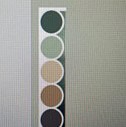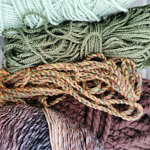Since the beginning of civilization, skilled artisans have painted, sculpted and built commissioned creations specifically designed to the requirements of a wealthy patron. The Medici's of the Italian Renaissance spent a fortune on fabulous palaces, interiors and sculpture as a display of their wealth and affluence, a concept evident when you consider all great masterpieces throughout the ages.

Craftisans today are very much in demand for personalised or bespoke items whether as a gift or something to perfectly match an interior. I see todays consumers gradually moving away from the mass produced, reduplicated wares commonly found on the internet or high street, and the trend changing from wanting to have what friends have, to wanting to have something unique. The idea of being a trend setter no doubt comes from the culture of todays society where being noticed can be deemed a sign of success. Having a desire to have fabulous things, telling friends about the find and the resulting wares becoming a trend is an in-the-flesh 'like', that temporary euphoric sensation we have all become addicted to, and what an amazing thing it is! I feel that some good has come from the internet for the arts, and that the ideals and values of the Arts and Crafts Movement are being realised again.
I am a huge advocate for this inspirational art movement from the late 19th century. The Arts and Crafts Movement was born of the Industrial Revolution as a rebellion against mass produced, machine made products. The concept of a handmade piece differs in so many ways compared to machine made. A man crafting some wood will feel and see what's not there, he will know how to manipulate the wood through years of practise, development and experience. He will lovingly apply a quality finish to emphasis the beauty of his work and to preserve it, until the piece is as perfect as he envisaged, and to finally pack it for delivery with the same artistry. The members of the movement looked to William Morris, who by 1880 had become an internationally renowned designer and craftsman.

This year I have noticed an increase demand for commissioned pieces. There is no greater achievement for an artist than to be asked to do a commission. I have been totally spoilt with the abundance of information I have been sent, from photos of mood boards and colour palettes, to photos of rooms and floors. Long gone are the days when I'm asked if I can make a 'blue and green bird'. Now I'm asked for a bird in 'teal, forest greens with steely and French blues!' Knowing exactly what is being asked, is the key to producing the required object.
Here is a perfect, recent example of how being given the right information can enable a Craftisan to make a successful commission. I have permission to use these photos and it was this project that inspired this blog.
Above The two photographs on the left were sent to me in order to create two hanging birds that had to be twins, but not identical twins. The two photographs on the right are the ones I replied with, to show which colour wools were the best match to the colour palette and I had been told the main colours were oak brown and sage green! (as I said earlier, long gone are the days of 'brown and green!'). Bare in mind that digital colour varies from each electronic device. This is why I have a colour match service, where for a tiny cost I send out wool swatches on a numbered card, which matches a card I have here. Simply message me your choices and I will make an exactly colour match.

Left is the photograph I was sent to show the birdies in situ in their forever homes. They are identical except their bodies have different proportions of light and dark green and I used different browns for their beaks. As you can see from this photo, because I had been given so much information I was able to produce birdies that look like they came with the shower curtain, sat there on the branches!! It was a fabulous project because i knew exactly what was wanted. Thanks to Cat (not me!) for the use of your photographs and a wonderful little birdie project.
Here's a guide about commissioned works from the point of view of the artist.
The more information you can supply, the more true to life the object will be. Artists see the world differently, we look at the space around an object, we notice a yellow thing is actually shades of lime green and buttermilk cream and we notice the proportions of a composition.
Provide as much visual information as possible, even if it is just photographs of anything so long as they show the colours/theme/shape you have chosen
Showing the theme of the room/purpose of the object will also help the artist interpret your idea
Remember a good artist will say if something isn't going to work. Personally if the brief isn't going to work either through the composition or colour, I will say so. However, a good artist will also offer several alternatives. Artistic License is the gift every creative person has, when he knows he will only be making something to the standards he is prepared to put his name on. I would not make something that is going to look bad if my name is on it.
Be prepared to answer several questions about you idea. Generally for each commission there is usually 3-4 messaged questions.
Part of the thrill of having something bespoke made is seeing it's development. I always send 1 or 2 'progress photos', not just to prove the job is underway, but because it aides to build-up anticipation and excitement. It also allows for any changes if there's errors in the interpretation.
Ask for a photograph of the item before it's completely made. I always send a picture when the object is nearly finished. This again adds to the thrill and anticipation, but I never send a completed picture, as that would take the edge off the initial response once the item is received
I always include a hand written note, describing anything that was note worthy on a personal level during the making process
There should never be the need to return a commissioned piece, unless it breaks or doesn't work.
It is my firm belief that the principles of the Arts and Crafts Movement are resurfacing which is my own personal utopia. Today it is possible to search on a visual platform such as Pinterest, find an artist making what you want, get in contact and off you go. There are several Craftisan selling platforms offering different levels of shopper and maker security which is hugely beneficial for the small workshops that William Morris saw as the progression of the manufacture of everyday objects.

I have developed Cat's Punky Stuff with the same values that Morris had hoped for. The mechanics of my construction is simple, neat and bold, like the medieval crafts the Arts and Crafts Movement aspired to. I make everything as if it is the most important object ever, every defect or error redone, anything not of a good enough standard is unpicked. That same care goes into communication with the patron and ends with the elaborate, luxurious packaging of the finished piece. There is no greater reward than a fabulous review for that special little thing that you gave life to.
Resent review for a Lavender wand. William Morris would be so proud!
5*
Receiving a delivery from Cat's Punky Stuff is like receiving a surprise gift from a good friend. Not only are the items themselves of excellent quality, but they are packaged with such beauty and care. I bought this wand as a present, but it has such good energy in it that I might just keep it for myself!

















留言